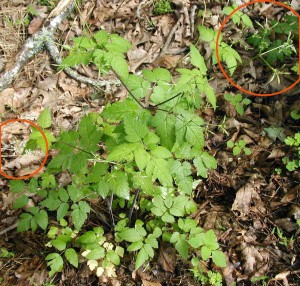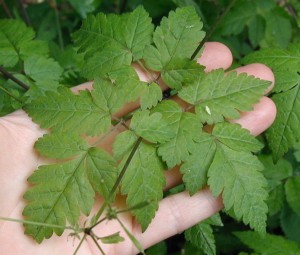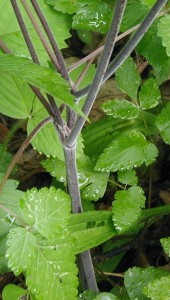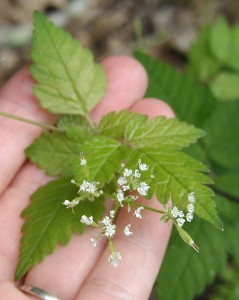The Parsley family, Umbelliferae or Apiaceae, encompasses dozens of useful plants with similar features, like flowers with five petals in umbels or umbrella-like clusters near the top of the plant. Leaves are toothed and divided, sometimes very finely. Examples are herbs and roots we commonly use in the kitchen, like parsley, dill, cilantro, fennel, and carrots.
Two native Parsley family members that can be found in the woodlands of the eastern U.S. are Sweet Cicely, Osmorhiza claytonii, and Anise Root, O. longistylis, which are very similar in appearance. Either of these woodland plants would look nice in a herb garden. The foliage is leafy and fern-like and the flowers dainty.
The main character differences are that Sweet Cicely is a softly hairy plant, while Anise Root is nearly smooth. Also, anise root has slightly longer stamen tips, hence the specific epithet longistylis.
The anise root plant photographed here was growing along a country road. It was still flowering near the end of May in Pennsylvania.

(Click on any photo to see a larger image.)
Take Caution: The leaves of Poison Hemlock, Conium maculatum, are similar in appearance. Do not ingest any part of any plant without a positive identification.
Sweet Cicely and Anise Root leaves are less highly divided, and potentially much smaller than, the leaves of poison hemlock.

Poison hemlock leaves have a bad smell when crushed, unlike the Osmorhiza which smell of anise or licorice. The sense of smell may be a poor indicator for some folks, so do not rely on this feature alone to distinguish poison hemlock from anise root.
Anise root stems are purple and smooth, while the stems of poison hemlock are spotted with purple.

Poison hemlock umbels are full of tiny flowers that make them look like several white spheres that may be held several feet high. Overall, poison hemlock plants are more substantial and grow taller. The umbels in Sweet Cicely and Anise Root are much more sparse with flowers than those of poison hemlock and they rise only 1-2 feet off the ground.

Peterson’s Edible Wild Plants Guide tells us that the roots and green fruits smell of anise and that they can be used for flavoring. I’m curious, does anyone use this woodland herb?